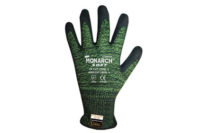There are 110,000 lost-time hand injuries annually. Hand injuries send more than one million workers to the emergency room each year. And 70 percent of workers who experience hand injuries are not wearing gloves.
OSHA states that of all injures reported, injuries to fingers and hands account for more than 23 percent, making them the highest in preventable injuries; in terms of lost work days, they rank second only to back and neck injuries.
A National Safety Council study reports that the cost of just one disabling hand or finger injury varies from $540 to $26,000 per patient, with a serious upward extremity trauma averaging $730,000 per incident.
In a press release from the International Safety Equipment Association, Rodney Taylor, D3O global sales and marketing manager said, “For impact protective gloves, performance can vary widely by manufacturer. Yet, without a performance standards infrastructure in place for impact protection, there is no reliable means of making comparisons between different products on an equal basis.”
To-date no uniform tests exist to evaluate gloves for impact protection.
Scope of standard
According to ISEA, standards and guidance have been in place for certain types of hand injuries such as those caused by cuts, punctures and chemical exposure. But there has been no standardized approach to address dorsal or back-of-hand injuries such as bone breakage and fractures, bruising and finger pinching.
To address the gaps in appropriately evaluating performance of a glove’s dorsal protection and to assist employers in making informed product selections, ISEA is developing this new standard to establish testing, classification and labeling requirements that offer back-of-the-hand impact protection. These are commonly used in the automotive, heavy equipment and construction operation, cargo handling, oil /gas and towing/transportation industries.
Compliant gloves will be evaluated for their capability to dissipate impact forces on the knuckles and fingers and are classified accordingly. The resulting classifications will be used by employers as a reliable means of comparing different products on an equal basis when selecting hand protection relative to the tasks being performed.
Key definitions
- The side of your hand that is palming or grasping is called the palmar aspect of your hand. This describes something located in, on or pertaining to the palm of the hand. The opposite side of your hand, the back of your hand, is called the dorsal aspect of the hand.
- The dorsal surface of a body is the back -- think of it as if you were a fish, and you had a dorsal fin. In the anatomical terms of location, it's anything of or pertaining to the back of any vertebrate. So the back of your hand is the dorsal side of your hand.
Key standard takeaways
- Impact sites are the location on a glove where testing will take place.
- Performance level is a numerical representation of impact protection offered by a glove. A higher performance level indicates a greater degree of protection (reduced transmitted force).
- Protective bumper(s) is additional material attached to the glove and intended to provide impact protection.
- Impact-resistant hand protection gloves will be tested by an independent ISO/IEC 17025 accredited laboratory to verify performance to the requirements specified in the standard.
- One pair of size 9 or 10 gloves shall be used for testing.
- The palm side of glove shall be removed before testing; gloves shall be opened out flat by cutting along the junction of the palm and back of glove.
- This is how gloves will be tested: Position the sample with the impact point in the center of the dome. Raise the drop striker to a height that will provide the required impact energy. Release the falling mass and record the peak force detected by the load cell or other sensor beneath the anvil. Repeat the procedure for the remaining impact sites as specified below:
- Knuckles — both gloves shall be tested eight impacts in total.
- Fingers and Thumbs — both gloves shall be tested ten impacts in total.
- The test includes calculating the mean of the peak forces recorded during testing of each zone separately. Individual forces and the means of the forces will be recorded.
Impact injury potential to hands
Our hands consist of 27 bones, including eight in the wrist, in addition to nerves, tendons, muscles and ligaments. Working hands are exposed to many types of injuries – lacerations, cuts, punctures, skin irritation, burns, sprains and strains, fractures and broken bones, and amputations.
When blunt trauma occurs, it is often around moving equipment and machinery. Due to the force and weight usually involved, the consequences of these injuries can be severe, including fractures and broken bones.
Falling from height is another cause of such injuries.
A broken hand can occur when enough force is applied to a bone to break it. Different variations of a fracture include:
- Stable fracture, when the bone pieces are aligned;
- Unstable fracture, when there are bone fragments that have shifted;
- Comminuted fracture, when the bone is shattered into many pieces; 4) Open (compound) fracture, when a bone fragment breaks through the skin. This causes risk of infection.
Symptoms of a broken hand can include: pain and stiffness; difficulty moving the hand, wrist and/or fingers; and deformities such as a crooked finger (this is less likely).
How do you know if your hand is broken or just bruised? According to WebMD, a broken wrist or broken hand might cause these signs and symptoms: severe pain that might worsen when gripping or squeezing or moving your hand or wrist; swelling; tenderness; bruising; obvious deformity, such as a bent wrist or crooked finger; stiffness or inability to move your fingers or thumb; and numbness in your hand or fingers.



